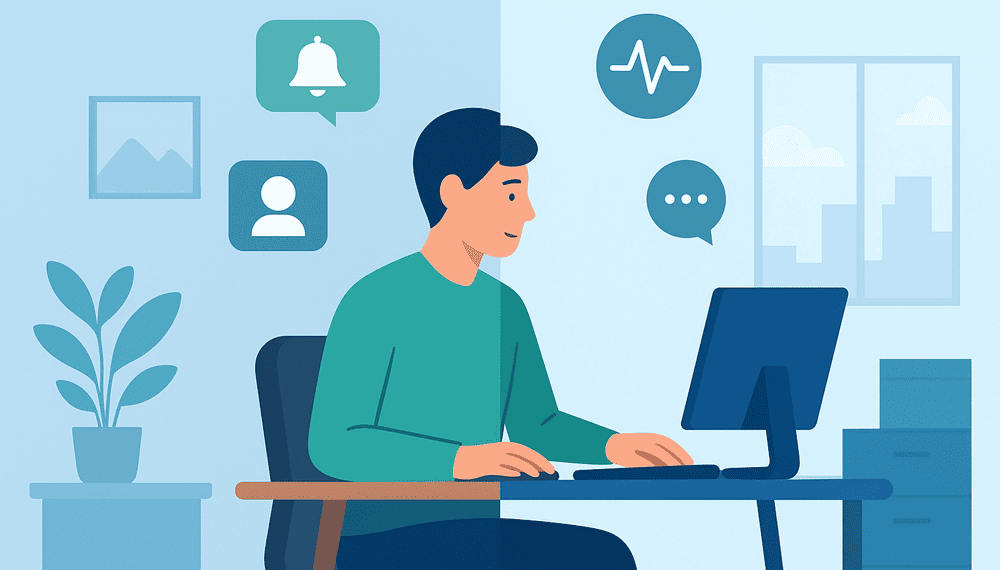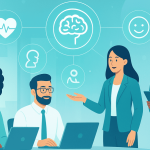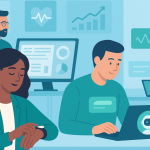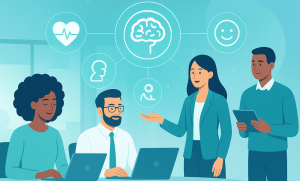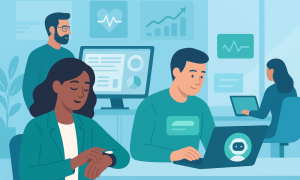The hybrid workplace has quickly become the dominant model for organizations worldwide. Employees split their time between home and office, enjoying flexibility while businesses benefit from reduced costs and wider talent pools. Yet this model also brings unique challenges, with hybrid work burnout rising as one of the most pressing issues for employers and employees alike.
Striking the right balance between in-person and remote schedules can leave workers feeling overstretched. Many find themselves “always on,” juggling longer commutes on office days with extended hours when working from home. Without proper support, this combination creates a perfect storm for stress, fatigue, and disengagement.
Organizations are increasingly turning to AI burnout prevention tools to manage these challenges. Intelligent coaching systems, wellbeing dashboards, and stress detection technologies offer new ways to help employees navigate the pressures of hybrid work.
Why Hybrid Work Leads to Burnout
Hybrid models promise flexibility, but they often lead to blurred boundaries. Employees report several recurring struggles:
- Uneven workloads: Office days can be jam-packed with meetings, while remote days stretch into late-night hours.
- Cognitive overload: Switching between virtual and in-person communication requires mental adjustment.
- Isolation and disconnection: Time spent away from colleagues can reduce a sense of belonging.
- Routine disruption: Hybrid work often prevents people from settling into consistent rhythms.
These factors contribute to hybrid work stress. Research indicates that employees working in hybrid setups may be more prone to burnout than fully remote or fully in-office workers, precisely because of the constant shifting between environments.
The Role of AI in Burnout Prevention
Artificial intelligence is not just a tool for automation. It is emerging as a wellbeing partner for employees. By analyzing patterns in behavior, workload, and engagement, AI systems can deliver coaching for hybrid workers that is personalized, timely, and actionable.
1. Real-Time Stress Detection
AI systems can track indicators such as workload distribution, meeting schedules, and even keystroke rhythms to detect early signs of fatigue. By identifying when an employee’s output is dipping or when their activity levels suggest exhaustion, AI can intervene with recommendations for rest or rebalancing.
These real-time insights align with practices in AI Stress Reduction, where digital prompts remind workers to pause, breathe, or step away before stress escalates into burnout.
2. Personalized Coaching for Hybrid Workers
Not every employee experiences hybrid work in the same way. Some thrive in flexible settings, while others struggle with the lack of structure. AI-powered coaching platforms adapt their recommendations to each individual, offering custom support for energy management, meeting preparation, or post-work recovery routines.
For example, an AI coach can suggest:
- A mindfulness break after a string of back-to-back video calls.
- A reminder to finish work at a reasonable hour when remote days run late.
- Guidance for managing anxiety before high-pressure in-person meetings.
This approach mirrors strategies often used in Workplace Mindfulness practices, giving employees the tools to maintain presence and calm throughout their day.
3. Data-Driven Support for Managers
Hybrid work also creates challenges for leadership. Managers can struggle to recognize who is overwhelmed, especially when team members are scattered. AI tools aggregate anonymized wellbeing data, showing trends such as peak stress hours, underutilized vacation days, or team-wide dips in energy.
This allows managers to act early, redistributing workloads or scheduling team wellness activities. Rather than relying solely on annual surveys, AI provides continuous insights into employee health.
4. Encouraging Work-Life Boundaries
Hybrid models often blur the lines between professional and personal life. AI burnout prevention systems help restore balance by nudging employees to log off at consistent times, encouraging breaks during the day, and discouraging after-hours communication.
These features build healthier habits and reduce the likelihood of long-term fatigue. Just as fitness trackers remind users to move, AI wellbeing platforms remind employees to protect their mental space.
Case Study Example: Preventing Burnout in a Hybrid Tech Firm
A mid-sized technology firm shifted to a hybrid model with three in-office days and two remote days per week. Within months, managers noticed rising complaints about fatigue and declining team morale. Many employees felt overwhelmed on office days, while remote days blurred into long, screen-heavy hours.
The company introduced an AI coaching platform focused on hybrid workplace wellness. Features included:
- Real-time nudges for stretching and screen breaks.
- Weekly analytics showing when stress was highest.
- Personalized suggestions for managing workloads on office days versus remote days.
After six months, results showed:
- A 25 percent reduction in reported burnout symptoms.
- Increased productivity during both office and remote hours.
- Higher employee satisfaction scores, particularly among younger staff who appreciated digital-first support.
This case demonstrates how technology can play a direct role in Managing IT Burnout and extending support to employees across different industries.
Why AI is Especially Valuable in Hybrid Work
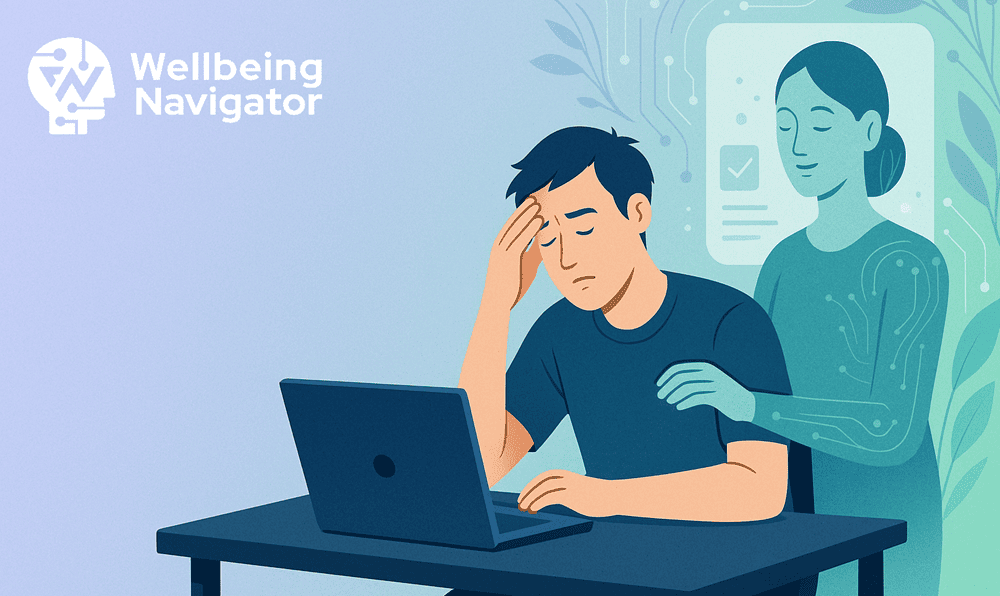
Always On Support
With employees splitting time between office and home, HR leaders cannot always check in personally. AI provides consistent monitoring and coaching, filling in the gaps.
Scalable Solutions
A single coach cannot effectively manage hundreds of employees across multiple time zones. AI offers scale without sacrificing personalization.
Confidential Conversations
Some employees feel more comfortable sharing their struggles with an AI assistant rather than a manager. This creates safe spaces for workers who might otherwise stay silent.
Integration with Workflows
AI burnout prevention tools can integrate directly into platforms employees already use, such as email, chat, or scheduling apps. This makes wellbeing support a seamless part of the workday.
How Companies Can Implement AI Burnout Prevention
- Assess workforce needs: Understand the specific pressures of your hybrid teams.
- Select the right platform: Choose AI tools with empathetic interfaces and privacy-first design.
- Train managers to interpret data: AI provides insights, but leadership must know how to act on them.
- Blend AI with human support: Ensure pathways exist for escalation to counselors or human coaches when needed.
- Measure impact: Track absenteeism, engagement, and employee satisfaction to prove ROI.
The Future of Hybrid Workplace Wellness
The future of work will not be entirely remote or entirely in-office. Hybrid models are here to stay, which means employee fatigue AI solutions will become central to workplace strategy. Advances in sentiment analysis, predictive modeling, and conversational AI will allow organizations to spot stress long before it turns into burnout.
We can also expect more personalized integrations, such as voice-based wellbeing prompts during meetings or predictive scheduling tools that recommend optimal in-office and remote days for each employee.
Conclusion
Hybrid work brings flexibility but also new mental health risks. Without support, employees face mounting stress, fatigue, and disconnection that can quickly spiral into hybrid work burnout.
AI burnout prevention tools offer a practical, scalable, and human-centered solution. By providing personalized coaching, monitoring stress in real time, and empowering managers with actionable insights, AI helps employees protect their energy, maintain balance, and stay engaged.
From guiding workers through Workplace Mindfulness practices, to offering structured digital methods for AI Stress Reduction, to addressing industry-specific needs such as Managing IT Burnout, artificial intelligence is not just reshaping productivity, it is redefining the future of employee wellness.
Organizations that embrace these tools today will build hybrid cultures that are not only more productive but also more sustainable for the people who power them.

